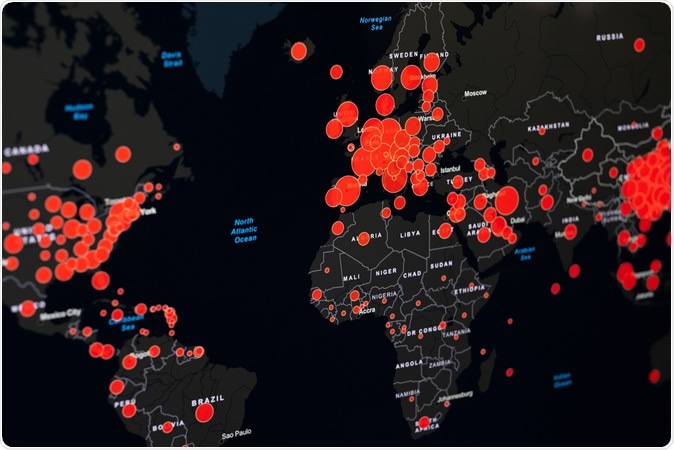The COVID-19 pandemic affecting 185 countries and territories the world over has already claimed over 190,000 lives and sickened well over 2.7 million as of April 24, 2020. Research shows that most of these fatalities are in older people or those who have underlying medical conditions.
The current study published on the preprint server medRxiv aims to estimate the number of people who are at risk for severe COVID-19 illness, because the variation in this number between countries may help to frame plans that can reduce the exposure of those groups at highest risk from the infection.

How many are at increased risk of severe COVID-19 disease? Rapid global, regional and national estimates for 2020. Image Credit: VK Studio / Shutterstock
How was the study done?
The researchers looked at the number of people at higher risk of severe infection with the virus, stratifying them by age groups spanning five years each, by sex, and by country. They drew their data on the prevalence of infection from the Global Burden of Disease (GBD) study for 2017 and the United Nations population estimates for 2020.
They found the number of older people at risk for severe illness, using different age limits from 50 to 70 years.
They also identified the comorbid conditions that could pose a risk for severe COVID-19 illness by linking the diseases in the GBD to the guidelines issued by the World Health Organization and the UK/US public health organizations. This allowed the prevalence of each of these conditions to be derived by country, age, and sex.
They examined two extensive studies of individuals with multiple illnesses to determine how best to adjust the data for disease clusters and the presence of multiple diseases in the same person.
The scientists developed a method to quickly evaluate the number and the percentage of the population of each country that would require to be shielded from the infection.
What did the research show?
The researchers arrived at an estimate of 1.7 billion people globally who may be at higher risk for severe illness due to COVID-19. This does not include older people without any underlying disease.
At age 25, 1 in 10 individuals had one such condition at least. By the time they were 50 years of age, the proportion went up to 1 in 3, and to 2 in 5 by age 70. This means, say the researchers, that almost 1 in 4 (23%) of the working-age global population (from 15 to 64 years) is at risk from at least one comorbidity.
These individuals are not equally distributed, varying from about 16% of the African population to approximately 31% of the European population.
The most common underlying diseases in individuals over 50 years include chronic kidney disease, cardiovascular disease, diabetes mellitus, and chronic lung disease. In Africa, the at-risk population also included nations with a high HIV prevalence and Islanders with a high diabetes rate.
The percentage of people with more than one comorbidity in Europe was threefold that in Africa, with one in 10 Europeans having multiple illnesses, but only 3% of Africans. Overall, 0.4 billion individuals have two or more existing health conditions that increase the risk of severe COVID-19.
The study concludes that if the current advisories and prevalence data of diseases from GBD are any guide, about 20% of people on earth have at least one risk factor for severe COVID-19 illness. Many of them are not likely to have this condition identified or to have it in a mild enough form that it escapes clinical notice. These include stage 1 cardiovascular disease, early-onset diabetes, and chronic liver disease with compensation. Sometimes, the condition is so mild as not to pose a serious risk.
On the other hand, the fact that a very high percentage of poor outcomes from COVID-19 occurs in people with underlying health issues, protecting these groups could be the way out to reduce the death rate and cut the demand for hospital beds. In many low-income countries, the low coverage by healthcare for many chronic conditions may mean that age will become the
Since no vaccine is yet available, these groups should be given priority in terms of timely and effective education about their increased risk, and support in adhering to guidelines such as frequent handwashing, home delivery of food and medical care, and physical separation from those who may spread the virus to them.
The problem with such shielding approaches is that they don’t work when the person at risk and who needs to be shielded is the one who needs to go out for work or to care for the others. Alternatives in such cases need to be explored, such as face masks, or incentives to not go for work.
With respect to healthcare providers and social welfare personnel, personal protective equipment (PPE) and intensive testing is a must for those on the front line.
The researchers say, “There is an urgent need for robust analyses of the risks associated with different underlying conditions so that countries can identify the highest risk groups and develop targeted shielding policies to mitigate the effects of the COVID-19 pandemic.”
Important Notice
medRxiv publishes preliminary scientific reports that are not peer-reviewed and, therefore, not be regarded as conclusive, guide clinical practice/health-related behavior, or treated as established information.
Journal reference:
Clark, A., Jit, M., Warren-Gash, C. et al. (2020). How Many Are At Increased Risk Of Severe COVID-19 Disease? Rapid Global, Regional And National Estimates For 2020. medRxiv. doi: https://doi.org/10.1101/2020.04.18.20064774 https://www.medrxiv.org/content/10.1101/2020.04.18.20064774v1